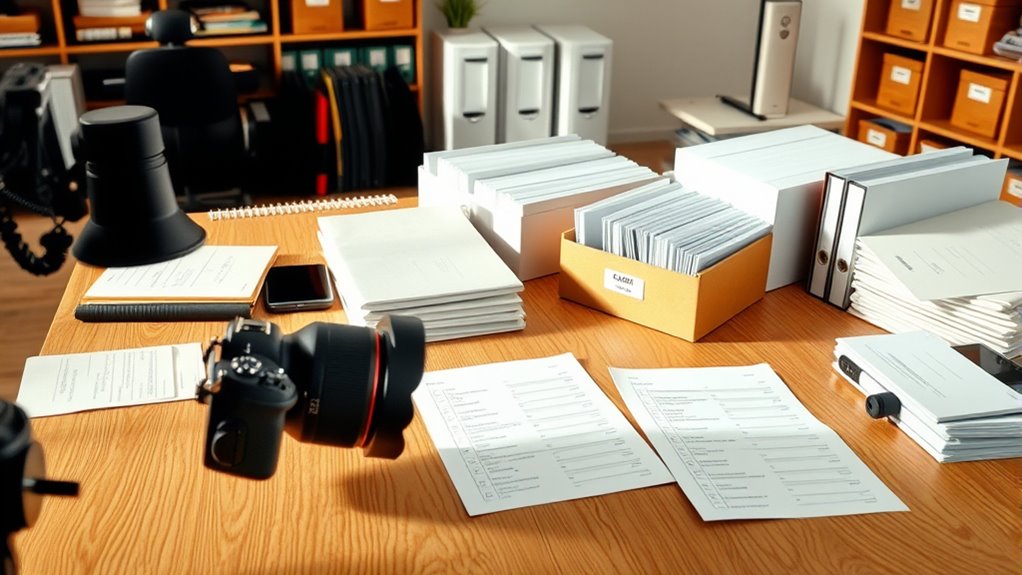Before you start your long-term storage, inspect your items for cleanliness and dryness, then choose stable, climate-controlled spaces with proper ventilation. Use sturdy, acid-free packaging and cushioning materials like bubble wrap, labeling each box clearly. Incorporate pest repellents, regularly inspect your storage, and keep a detailed inventory. Following these advanced steps guarantees your belongings stay protected. Keep going to discover more expert tips to optimize your storage preparations.
Key Takeaways
- Assess and optimize storage environment for stable temperature, humidity, and ventilation to protect sensitive items.
- Select appropriate, durable packaging materials and clearly label each container with contents and handling instructions.
- Thoroughly clean, dry, and declutter items before packing, grouping similar items for organized storage.
- Implement pest control measures and regularly inspect storage for signs of moisture, pests, or damage.
- Maintain a detailed inventory and conduct periodic inspections to monitor condition and update records.
Essential Tips for Long-Term Storage Preparation

When planning for long-term storage, thorough preparation is essential to guarantee your items remain safe and preserved over time. One of the most critical steps is ensuring your storage environment is suitable, which often means focusing on climate control. Fluctuations in temperature and humidity can cause damage, warping, mold, or deterioration of your belongings. To combat this, you should select a storage space with stable climate conditions or invest in climate control solutions like dehumidifiers and temperature regulators. Maintaining consistent temperature and humidity levels minimizes the risk of damage, especially for sensitive items like documents, electronics, or antiques. Implementing proper ventilation can also help prevent moisture buildup and mold growth in your storage area. Equally important is choosing the right packaging materials. Quality packaging materials act as the first line of defense against dust, pests, and physical damage. Use sturdy boxes that can withstand weight and stacking without collapsing. Acid-free boxes and tissue paper are ideal for preserving delicate items such as photographs or paper documents, preventing deterioration caused by acidic materials. Bubble wrap, foam padding, or packing peanuts provide cushioning for fragile objects, reducing the risk of breakage during handling or shifting over time. Label each box clearly, noting its contents and any special handling instructions, so you can easily locate what you need later and avoid unnecessary disturbance to your stored items. Before packing, it’s vital to declutter and clean everything thoroughly. Dirty or dusty items can attract pests or cause mold growth in your storage environment. Clean your belongings and let them dry completely before packing, ensuring no moisture gets trapped inside packaging materials. When packing, be systematic: group similar items together, fill empty spaces within boxes to prevent shifting, and use appropriate packaging materials for each item’s needs. For items susceptible to pests, consider adding pest repellents or using sealed, airtight containers. Lastly, create an inventory of everything you’re storing. This not only helps track your items but also ensures you’re aware of what’s inside each box, making future access easier. Regularly inspecting your storage unit is also essential. Look for signs of moisture, pests, or damage, and adjust climate control or packaging strategies as needed. Proper preparation, focusing on climate control and quality packaging materials, forms the foundation of effective long-term storage. It safeguards your valuables, preserves their condition, and extends their lifespan, giving you peace of mind that your stored items will remain in excellent condition over time.
Frequently Asked Questions
How Do I Select the Best Storage Containers for Long-Term Use?
To select the best storage containers for long-term use, look for ones with airtight seals to keep out moisture and pests. Choose durable materials like heavy-duty plastic or metal that won’t crack or degrade over time. Guarantee the containers are BPA-free and food-grade if storing edible items. Opt for stackable designs to save space, and verify that the lids fit securely for maximum protection.
What Are Common Mistakes to Avoid During Long-Term Storage Preparation?
Think of your storage as a fortress, and mistakes are the hidden cracks. Avoid common storage mistakes like using the wrong containers, neglecting proper sealing, or ignoring temperature controls. Preservation pitfalls often include overpacking or forgetting labels, causing chaos later. You must be vigilant, ensuring your setup is airtight, stable, and well-organized. This way, your treasures stay safe, preserved, and ready for future use, free from preventable damage.
How Often Should I Inspect My Stored Items for Preservation?
You should inspect your stored items at least twice a year to guarantee proper preservation. During inspections, focus on humidity control to prevent mold and pest prevention to keep pests out. Look for signs of moisture or pests, and adjust your storage environment as needed. Regular checks help you catch problems early, maintain ideal conditions, and prolong the life of your valuables. Consistent inspections are key to effective long-term storage.
Are There Specific Climate Conditions Ideal for Long-Term Storage?
You should aim for climate control with consistent temperatures around 60-70°F and humidity regulation between 30-50% for long-term storage. Avoid extreme fluctuations that can cause damage. Keep items in a cool, dry place, and use dehumidifiers or humidifiers as needed. Proper climate conditions help prevent mold, warping, or deterioration, ensuring your stored items stay preserved over time. Regularly monitor and adjust to maintain ideal storage conditions.
What Security Measures Can I Implement to Prevent Theft or Damage?
Think of your storage as a fortress guarding precious treasures. You can bolster security protocols like installing surveillance cameras, alarm systems, and sturdy locks to deter thieves. Keep a detailed inventory, use tamper-evident seals, and control access strictly. Regularly monitor your storage space, and consider insurance for added theft prevention. These measures create an impenetrable shield, ensuring your valuables stay safe from theft or damage over time.
Conclusion
By following these essential tips for long-term storage, you guarantee your items stay protected, organized, and preserved. Prepare thoroughly, choose wisely, and maintain regularly to prevent damage and decay. Keep your storage clean, monitor conditions, and update your inventory to stay in control. With careful planning and consistent effort, you’ll enjoy peace of mind knowing your belongings are safe and sound for years to come. Stay vigilant, stay proactive, and keep your storage space optimized and secure.









